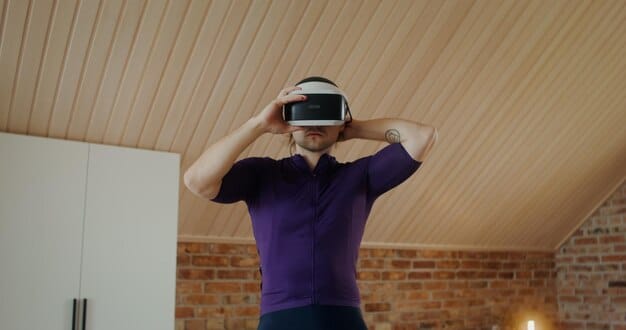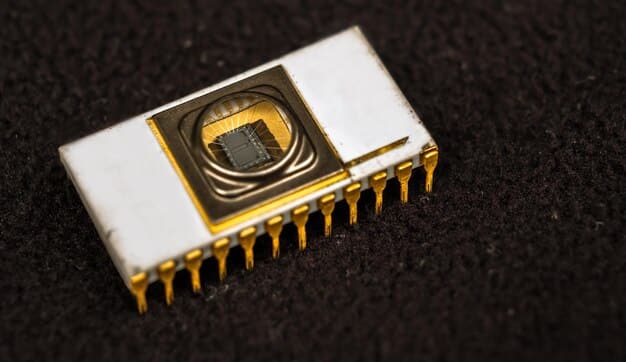Untethered VR: WiGig’s 60 GHz Revolution in 2025!

Untethered VR is poised to revolutionize virtual reality in 2025, with 60 GHz WiGig technology eliminating cable lag and enhancing immersive experiences through high-speed, low-latency wireless connectivity.
Imagine experiencing virtual reality without the annoying tether of cables. In 2025, that vision is becoming a reality thanks to the Untethered VR: How 60 GHz WiGig is Eliminating Cable Lag in 2025, a technological leap that promises to redefine immersion.
The Quest for Untethered VR
For years, the dream of virtual reality enthusiasts has been to achieve complete immersion without the constraints of cables. These tethers, while necessary for transmitting data and power, often detract from the experience by limiting movement and creating a sense of disconnect. The quest for untethered VR has led to exploration of various wireless technologies, with 60 GHz WiGig emerging as a frontrunner.
The desire for untethered VR stems from a simple need: freedom. Cables restrict movement, increase the risk of tripping, and generally break the illusion of being in another world. Eliminating these constraints opens up a new realm of possibilities for VR applications, from gaming and entertainment to training and collaboration.
Why Wireless VR Matters
Wireless VR translates to significantly improved user experiences. Without the cable, users can roam freely within a defined space, interacting more naturally with the virtual environment.
Challenges in Wireless VR
Achieving truly seamless wireless VR is not without its hurdles. Bandwidth, latency, and power consumption are critical factors that need optimization.
- Bandwidth: Demanding VR applications require high bandwidth to transmit high-resolution visuals and complex data.
- Latency: Low latency is crucial to avoid motion sickness and ensure real-time responsiveness.
- Power Consumption: Wireless VR headsets need to be power-efficient to provide extended usage without frequent recharging.
As the demand for immersive experiences grows, untethered VR offers a promising solution, but requires addressing the key challenges to unlock its full potential.

Enter 60 GHz WiGig: A Game Changer
WiGig, operating on the 60 GHz frequency band, is a wireless communication technology specifically engineered to provide bandwidth and low latency which makes it an ideal option for untethered VR. It has the ability to handle the immense data throughput needed for VR, with response times fast enough to prevent motion sickness.
This technology offers a significant leap in wireless performance, enabling real-time data transfer without the constraints of traditional Wi-Fi. Untethered VR is now viable as WiGig makes its way into headsets.
Technical Advantages of 60 GHz WiGig
The high-frequency band offers unique benefits, including wider channels and faster data rates. Bandwidth can also be very high.
Overcoming Distance Limitations
One limitation of 60 GHz WiGig is its shorter range compared to lower-frequency Wi-Fi. Innovative antenna designs and beamforming techniques are helping to overcome these limitations.
- Beamforming: Concentrates the wireless signal in a specific direction, increasing range and signal strength.
- Advanced Antenna Design: Compact antennas allow for integration into VR headsets without adding excessive bulk.
- Multi-hop networks: Extending coverage range by relaying signal, while is difficult in VR where obstacles may break LoS.
With these advancements, 60 GHz WiGig is poised to deliver the high-performance wireless connectivity required for truly immersive untethered VR experiences.
WiGig’s Impact on VR Hardware in 2025
By 2025, the incorporation of 60 GHz WiGig into VR hardware is set to transform the landscape of virtual reality. This technology enables the creation of lighter, more comfortable headsets, as developers can eliminate the need for bulky cables and external processing units.
Because of Untethered VR: How 60 GHz WiGig is Eliminating Cable Lag in 2025, the consumer VR landscape can expect improved designs and more powerful headsets.
Enhanced Mobility and Freedom
The absence of cables allows users to move freely and naturally within the virtual environment, enhancing immersion and reducing the limitations of traditional VR setups.
Streamlined Design and Ergonomics
VR headsets can be designed to be more compact and comfortable, removing the weight and bulk associated with cable connections. This is a boon for long periods of usage.
Potential for New VR Applications
Untethered VR opens doors to innovative applications in various fields, including:
- Gaming: More dynamic and interactive gaming experiences.
- Training: Realistic simulations for training in hazardous environments.
- Healthcare: Advanced tools for medical training and rehabilitation.
- Entertainment: Immersive entertainment experiences without the constraints of cables.
With greater portability and usability, VR hardware powered by 60 GHz WiGig will expand into new markets and revolutionize how we interact with virtual environments.

Challenges and Solutions for WiGig VR Adoption
Despite the transformative potential of 60 GHz WiGig, several challenges need to be addressed to ensure widespread adoption within the VR industry. These challenges include managing interference, optimizing power consumption, and ensuring compatibility across different VR platforms which all contribute to how Untethered VR: How 60 GHz WiGig is Eliminating Cable Lag in 2025, will perform.
Overcoming these obstacles is vital to unlocking the full potential of wireless VR experiences. Let’s break down a few key issues.
Mitigating Interference
The 60 GHz frequency band is susceptible to interference from other devices and environmental factors. Implementations such as dynamic frequency selection (DFS) and interference mitigation techniques are essential to maintaining a stable connection.
Power Efficiency
Maximizing battery life is critical for wireless VR headsets. Techniques like adaptive power scaling and efficient hardware design help reduce power consumption without sacrificing performance.
Ensuring Compatibility
Standardization efforts are necessary to ensure seamless interoperability between different VR headsets and base stations. This is essential to reduce fragmentation in the VR ecosystem.
Addressing these challenges through technical innovation and industry collaboration will pave the way for a smoother transition to untethered VR.
The Competitive Landscape: WiGig vs. Alternative Wireless Solutions
While 60 GHz WiGig stands out as a promising solution for untethered VR, it faces competition from other wireless technologies. Understanding the trade-offs between these technologies is crucial for making informed decisions about the future of wireless VR. Factors such as cost, availability, and support also are important considerations.
Assessing the strengths and weaknesses of each technology will shape the landscape of wireless VR solutions.
Wi-Fi 6E
Wi-Fi 6E extends the capabilities of Wi-Fi 6 into the 6 GHz band, offering increased bandwidth and reduced congestion. While Wi-Fi 6E provides improvements over previous Wi-Fi standards, it still falls short of WiGig’s data rates and latency performance.
5G
5G cellular technology offers high bandwidth and low latency, making it a potential candidate for wireless VR. However, 5G’s reliance on cellular infrastructure can be limiting in indoor environments. Also, 5G licensing and deployment costs can be prohibitive for some VR applications.
Proprietary Wireless Solutions
Some companies are developing proprietary wireless solutions optimized for VR. These solutions often offer advantages in terms of performance, but may suffer from limited ecosystem support.
The choice of wireless technology for VR depends on specific requirements and trade-offs. WiGig strikes a balance between performance, cost, and ease of deployment that makes it a compelling option for untethered VR in 2025.
The Future of Untethered VR Beyond 2025
Looking beyond 2025, the evolution of 60 GHz WiGig and other wireless technologies will continue to drive innovation in untethered VR. Advancements in areas such as artificial intelligence (AI), edge computing, and haptic feedback will further enhance the immersive VR experience.
These emerging technologies will redefine the boundaries of virtual reality and its applications.
AI-Powered VR
AI can enhance VR experiences through:
- Personalized Content: AI algorithms can analyze user behavior and preferences to tailor VR experiences.
- Intelligent Agents: AI-powered virtual assistants create enhanced interactivity to improve enjoyment.
- Real-time Optimization: AI can optimize wireless connectivity and resource allocation to ensure smooth performance.
Edge Computing
Pushing compute-intensive tasks to the network edge is a boon to untethered VR and allows headsets to be lighter and provide longer battery life.
The combination of 60 GHz WiGig with AI, edge computing, and haptic feedback will unlock new levels of realism and immersion in VR experiences. The future of untethered VR looks promising, with endless possibilities for entertainment, education, and beyond.
| Key Point | Brief Description |
|---|---|
| 🚀 Untethered VR | Eliminates cables for unrestricted movement. |
| 📶 60 GHz WiGig | Provides high-speed, low-latency wireless connectivity. |
| 💡 Hardware Impact | Enables lighter, more ergonomic VR headsets by 2025. |
| 🛡️ Challenges | Addresses interference, power consumption, and compatibility issues. |
FAQ
▼
Untethered VR refers to virtual reality experiences without the need for physical cables connecting the headset to a computer. This wireless setup allows users greater freedom of movement and enhances immersion.
▼
60 GHz WiGig provides a high-bandwidth, low-latency wireless connection, enabling real-time data transfer between the VR headset and the computer. This minimizes lag and ensures a seamless VR experience.
▼
Untethered VR offers greater mobility, enhanced immersion, and a more comfortable experience. It also reduces the risk of tripping and makes VR more accessible for various applications, including gaming, training, and healthcare.
▼
Challenges include managing interference, optimizing power consumption, and ensuring compatibility across different VR platforms. Overcoming these obstacles is crucial for widespread adoption of WiGig in VR.
▼
Competing technologies include Wi-Fi 6E, 5G, and proprietary wireless solutions. Each technology has its own strengths and weaknesses, but WiGig offers a compelling balance of performance, cost, and ease of deployment for VR.
Conclusion
The elimination of cable lag through technologies like 60 GHz WiGig marks a significant step forward in virtual reality. Untethered VR: How 60 GHz WiGig is Eliminating Cable Lag in 2025 is paving the way for more immersive, comfortable, and versatile VR experiences. As the technology continues to evolve, it promises to transform various industries and redefine how we interact with digital environments.





